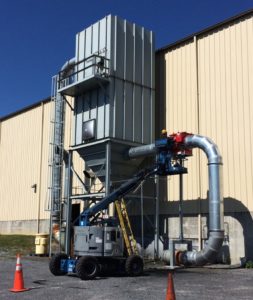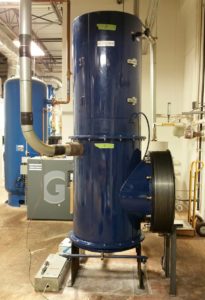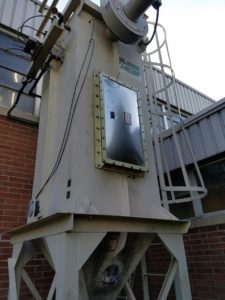
Baghouse on graphite dust, retrofitted with IEP Technologies Explosion vent and ProFlapPlus passive isolation valve. NFPA 69 compliant Rotary Airlock to be installed.
At a recent Lunch and Learn in greater Philadelphia, PA, I was asked about moving a dust collector to a new location within a plant and the attendee wanted to know what questions needed to be asked to satisfy applicable Codes and safety in general. I answered it using facts from a completed project.
Moving and retrofitting existing dust collectors to use in a different location within a plant or in another facility is not just a mechanical project, especially when you need to meet NFPA standards for fire and explosion protection. It might seem simple enough, but there are a few wrinkles that need to be considered that are often overlooked. It is not simply hiring a mechanical contractor and moving the collector to a new location, perhaps adding an explosion vent or an isolation valve and considering the job finished. Just meeting one and not all NFPA Standards is not complying with safety for your employees and protecting your facility which is what you are attempting to do.
Variables to Be Considered When Moving a Dust Collector
New Dust – If you are changing dust that you are collecting, the material characteristics, relative explosion severity or Kst values and maximum pressure Pmax for a specific dust may change based on how they are produced and handled and, i.e., not all sawdust or aluminum dust samples have the same Kst, Pmax values. Have the new dust tested. You might, in fact, be reducing the Kst, Pmax values that you need to meet. NFPA 652: Standard on the Fundamentals of Combustible Dust addresses specific criteria to be evaluated.
Dust Collector Location – Whether inside or outside and where in the plant the collector is to be located determines what explosion protection equipment required. Additionally, electrical classification of a specific process area of the plant might need to be considered. NFPA 70: National Electrical Code® may require process equipment be bonded and grounded as required with wiring and connections dust tight and ignition proof.

Spencer Vacuum unit retrofitted with HOERBIGER Flameless Explosion Vent.
Duct Construction – Is the duct structurally sound enough to withstand a deflagration? Is the duct round or rectangular? Is the velocity in the duct properly sized to prevent dust accumulation?
Components – Depending upon the dusts material characteristics, location, etc. you will need to examine passive verses active options. Whether choosing a vent – rupture style or flameless, mechanical valve or a flap valve, chemical suppression system, sprinklers or CO2 system, knowledgeable selection is required and vetting each piece of equipment before you purchase, and install is important. Not all products meet NFPA Standards or OSHA Directives. When choosing a rupture style vent panel ask yourself if the fireball is being directed to a safe area. NFPA 68 has equations you can use to determine the fireballs size.
Recirculating the Dust Back into the Building – NFPA 654 requires an isolation barrier when transporting cleaned air back into the workspace. Dependent upon KST and PMax this could require an active chemical isolation system or potentially a passive clean air isolation valve. Aside from the explosion system, a HEPA filter should be considered as well based upon local code requirements.
Rotary Airlock – If you have a rotary airlock, is it NFPA or NEC approved to be used in an explosive environment? Not just the drive motor but the valve interior construction. NFPA 69: Standard on Explosion Prevention Systems points out compliance requirement detail for rotary airlock compliance. SysTech can provide rotary valves that are easy drop-in replacement rotary airlocks in 8”, 10” and 12” sizes that are NFPA compliant.
Explosion Vent – If you’re using an existing collector, and it has an explosion vent already in place, is it designed for the material characteristics of the dust your handling? NFPA 68: Standard on Explosion Protection by Deflagration Venting is your guide for you to determine your options. If it does or doesn’t have a vent, have the dust evaluated immediately!
Collector Body – Is the design strength of the collector above the Pred (reduced pressure) of the explosion protection system? Is the collector body intact? Rust, loose gasketing or fasteners, etc. need to be vetted out. Reinforcing the housing may be an immediate requirement.
Fan – Is the fan AMCA rated for spark resistant? Is it non-sparking construction? Air Movement and Control Association’s (AMCA) Standard 99-0401, “Classification for Spark Resistant Construction.” defines several options.
Get Your Dust Tested

Camcorp dust collector reapplied to a plastic pellet process with new IEP Technologies explosion vent and ProFlapPlus passive isolation valve.
We cannot stress enough the need to get the dust tested. Do not “eye ball it” or assume it’s the same as another dust you’re presently handling. A Dust Hazard Analysis or DHA is a requirement of NFPA 654: Standard for the Prevention of Fire and Dust Explosions from the Manufacturing, Processing, and Handling of Combustible Particulate Solids and we’ll review it with you. You need to understand the Codes and it’s all part of what we do for clients.
SysTech routinely updates existing equipment to meet NFPA and safety requirements that clients require when they move and reuse dust collection equipment. There are options, and some are more cost effective than others. It’s important to know that our offering is in partnership with IEP Technologies – HOERBIGER Safety Solutions, one of the world’s leading providers of sophisticated safety and explosion protection technology. Call us, and we’ll collect the dust sample with you, send it to the IEP lab and have it evaluated; we’ll review your system and advise what is needed to meet the various NFPA Codes or OSHA Directives. Need to know specific NFPA Code section references? See attached by IEP Technologies MC 567 Air Material Separator Protection.
You’re a call away from getting the facts, finding a solution and being confident in a safe workplace.


